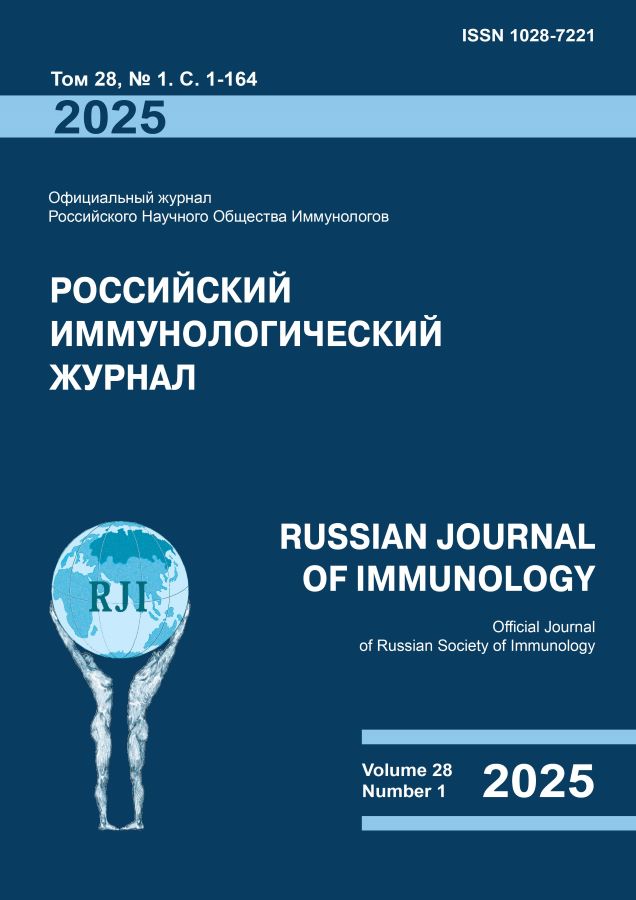Сontents of neuroimmunovascular factors and the state of microcirculation of bulbar conjunctiva in post-traumatic stress disorder in veterans of modern combat conflicts
- Authors: Pashnin S.L.1, Davydova E.V.1,2, Altman D.S.1
-
Affiliations:
- Chelyabinsk Regional Clinical Hospital
- South Ural State Medical University
- Issue: Vol 28, No 1 (2025)
- Pages: 109-116
- Section: SHORT COMMUNICATIONS
- URL: https://bakhtiniada.ru/1028-7221/article/view/277349
- DOI: https://doi.org/10.46235/1028-7221-16983-CON
- ID: 277349
Cite item
Full Text
Abstract
Chronic exposure to multimodal stress, e.g., allostatic overload leads to dysadaptive response of various organs and triggers pathophysiological mechanisms that contribute to development of post-stress disorders in veterans of modern military conflicts. Brain is a key stress response organ, and sustained matching of blood flow to metabolic demands of the brain is ensured by signaling mechanisms of neuroimmunovascular interaction. The purpose of the study was to assess the contents of humoral neuroimmunovascular factors, and the state of microcirculation at the ocular bulbar conjunctiva in post-traumatic stress disorder (PTSD) in veterans of modern military conflicts. Materials and methods: 35 veterans of a special military operation on the territory of Ukraine with a documented diagnosis of PTSD (ICD-10: F43.1; ICD-11: 6B40) aged from 25 to 60 years particioated in the study. Biomicroscopy of the ocular bulbar conjunction was performed using a slit lamp SLR 100 (K. Zeiss, Germany). The levels of following vasoactive factors were determined in blood by ELISA method: vascular endothelial growth factor VEGF (eBioscience test system, BenderMedSystems, Austria); endothelin-1 (BioMedica, Austria). The concentration of nitrites was determined by Gries reaction using the technique of N. Emchenko. The blood cytokine profile was studied with a Luminex Magpix 100 immunoanalyzer (USA), using Bio-Plex multiplex test system (MERZ, Germany), in order to determine IL-6, TNFá. The data were evaluated with SPSS program. Results and discussion: a study of blood microcirculation at the bulbar conjunctiva of veterans with PTSD revealed the predominance of spastic-atonic changes, mainly due to the capillary-venular component, emergence of arterial-venous anastomoses, aneurysms contributing to increase of hypoxic-ischemic changes in brain tissue, dystrophic changes, reduction of cerebral blood flow, being a consequence of vascular remodeling and neovascularization. There is an imbalance of vasoactive molecules in blood, with predominance of vasoconstriction effects associated with increased levels of endothelin-1, a vascular endothelial growth factor along with decreased concentrations of nitrite ions. We have shown increased systemic circulation of pro-inflammatory cytokines IL-6 and TNFá which may promote neuroinflammatory and neurotoxic processes in brain tissue. Conclusion. Development of neurocognitive post-stress disorders occurs in presence of accumulating “allostatic cargo”, being accompanied by maladaptive changes in the microcirculation of brain tissue along with disturbances in angioarchitecture, imbalance of vasoactive molecules, and increased contents of pro-inflammatory cytokines.
Full Text
##article.viewOnOriginalSite##About the authors
S. L. Pashnin
Chelyabinsk Regional Clinical Hospital
Email: davidova-ev.med@yandex.ru
Neurosurgeon, Honored Doctor of Russian Federation, Head, Department of Neurosurgery
Russian Federation, ChelyabinskE. V. Davydova
Chelyabinsk Regional Clinical Hospital; South Ural State Medical University
Author for correspondence.
Email: davidova-ev.med@yandex.ru
PhD, MD (Medicine), Associate Professor, Professor, Department of Medical Rehabilitation and Sports Medicine, Head, Department of Early Medical Rehabilitation
Russian Federation, Chelyabinsk; ChelyabinskD. S. Altman
Chelyabinsk Regional Clinical Hospital
Email: davidova-ev.med@yandex.ru
PhD, MD (Medicine), Professor, Honored Physician of the Russian Federation, Chief Physician
Russian Federation, ChelyabinskReferences
- Емченко Н.Л., Цыганенко О.И., Ковалевская Т.В. Универсальный метод определения нитратов в биосредах организма // Клиническая лабораторная диагностика. 1994. № 6. С. 19-20. [Emchenko N.L., Tsyganenko O.I., Kovalevskaya T.V. Universal method for determining nitrates in biological media of the body. Klinicheskaya laboratornaya diagnostika = Russian Clinical Laboratory Diagnostics, 1994, no. 6, pp. 19-20. (In Russ.)]
- Севрюкова Г.А. Реостаз, аллостаз и аллостатическая нагрузка: что понимается под этими терминами? // Международный научно-исследовательский журнал, 2022. № 10 (124). [Электронный ресурс]. Режим доступа: https://research-journal.org/archive/10-124-2022-october/10.23670/IRJ.2022.124.22. [Sevryukova G.A. Rheostasis, allostasis and allostatic load: what is meant by these terms? Mezhdunarodnyy nauchno-issledovatelskiy zhurnal = International Scientific Research Journal, 2022, no. 10 (124). [Electronic resource]. Access mode: https://research-journal.org/archive/10-124-2022-october/10.23670/IRJ.2022.124.22. (In Russ.)]
- Bernberg E., Ulleryd M.A., Johansson M.E., Bergström G.M. Social disruption stress increases IL-6 levels and accelerates atherosclerosis in ApoE-/- mice. Atherosclerosis, 2012, Vol. 221, no. 2, pp. 359-365.
- Burrage E., Marshall K.L., Santanam N., Chantler P.D. Cerebrovascular dysfunction with stress and depression. Brain Circ., 2018, Vol. 4 , no. 2, pp. 43-53.
- Chu L.Y., Ramakrishnan D.P., Silverstein R.L. Thrombospondin-1 modulates VEGF signaling via CD36 by recruiting SHP-1 to VEGFR2 complex in microvascular endothelial cells. Blood, 2013, Vol. 5, no. 122 (10), pp. 1822-1832.
- Griffin B.J., Purcell N., Burkman K., Litz B.T., Bryan C.J., Schmitz M., Villierme C., Walsh J., Maguen S. Moral Injury: An Integrative Review. J. Trauma Stress, 2019, Vol. 32, no. 3, pp. 350-362.
- McEwen B.S., Gianaros P.J. Central role of the brain in stress and adaptation: links to socioeconomic status, health, and disease. Ann. N. Y. Acad. Sci., 2010, no. 1186, pp. 190-222.
- Mineur Y.S., Prasol D.J., Belzung C., Crusio W.E. Agonistic behavior and unpredictable chronic mild stress in mice. Behav. Genet., 2003, Vol. 33, no. 5, pp. 513-519.
- Lee S., Kang B.M., Shin M.K., Min J., Heo C., Lee Y., Baeg E., Suh M. Chronic stress decreases cerebrovascular responses during rat hindlimb electrical stimulation. Front. Neurosci., 2015, Vol. 9, 462. doi: 10.3389/fnins.2015.00462.
- Liu Y., Mladinov D., Pietrusz J.L., Usa K., Liang M. Glucocorticoid response elements and 11 beta-hydroxysteroid dehydrogenases in the regulation of endothelial nitric oxide synthase expression. Cardiovasc. Res., 2009, Vol. 81, no. 1, pp. 140-147.
- Phelps A.J., Steel Z., Metcalf O. Key patterns and predictors of response to treatment for military veterans with post-traumatic stress disorder: a growth mixture modelling approach. Psychol. Med., 2018, Vol. 48, no. 1, pp. 95-103.
- Toussaint F., Charbel C., Allen B.G., Ledoux J. Vascular CaMKII: heart and brain in your arteries. Am. J. Physiol. Cell Physiol., 2016, Vol. 311, no. 3, pp. 462-478.
- Williamson V., Murphy D., Stevelink S.A.M., Allen S., Jones E., Greenberg N. Delivering treatment to morally injured UK military personnel and Veterans: The clinician experience. Mil. Psychol., 2021, Vol. 33, no. 2, pp. 115-123.
Supplementary files







